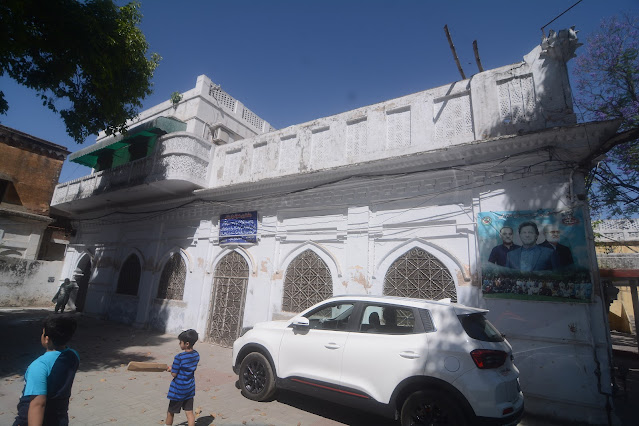23rd April 2023
"All images copyright 2023 Mirza Ali Usman Baig. This article was written after referencing Muhammad Hassan Miraj's article, 'The Burj,' published in Dawn on October 02, 2012."
Wazirabad, a city steeped
in history, was established by Wazir Khan, the governor, and later Grand Vizier
of Mughal Emperor Shah Jahan, during the 17th century. One of the city's
remarkable historical wonders is Saman Burj, also known as Musamman Burj.
The Persian term
"Musamman" translates to figure eight, and these 57 canals of history
encompass a vast complex of structures. The two main gates feature a
configuration of four watchtowers each, giving rise to the moniker
"Musamman Burj." The Musamman Burj in Agra is also renowned for its
distinctive architecture.
Legend has it that
Jehangir and his wife, Noor Jehan, frequently stayed at Musamman Burj while en
route to Kashmir. This location was formerly the Royal Sarai erected during
Emperor Jehangir's reign in 1601 AD. Each year, when the Chenab River was
flowing strongly, the emperor and his queen would spend several days at the
site while traveling from Lahore to Kashmir.
Charat Singh, Maharaja
Ranjeet Singh's grandfather, took over Saman Burj when the Mughal Empire was in
decline in 1752. After renovating the complex, he added new structures and took
up residence there. His son Maha Singh, the father of Maharaja Ranjeet Singh,
subsequently occupied the site.
At present, it is
noteworthy that neither Sikhs nor Mughals inhabit Saman Burj. The current
inhabitants claim to be the relatives of Mughal Emperor Aurangzeb Alamgir's
second wife, Begum Bai, a Jaral Rajput from Rajauri in Indian-occupied Kashmir.
Begum Bai was also Emperor Shah Aalam's mother.
In 1799, when the Mughal
empire was in decline, the Sikh empire led by Ranjeet Singh gained control of
parts of Punjab and Kashmir, including Rajauri. However, "Maharajah
Ranjeet Singh of Punjab had occupied Rajouri and other Punjab Hills States in
1813. But he had allowed the Raja of Rajaur (Aagar Khan) to rule the
state."
After the British defeated
the Sikhs in the first Anglo-Sikh war in 1846, they sold Kashmir to Dogra Singh
under the treaty of Amritsar, and the Jarral Rajas were forced to abandon their
palaces and homes. Overwhelmed with sadness at the loss of their land, which
they had ruled for six centuries, the Rajas left Rajauri and relocated to Rehlu
in Kangra, Punjab.
Subsequently, due to a
family dispute, a member named Raja Fakirullah purchased the land with Rs 6,000
from the British and moved into Wazirabad's Saman Burj. It is said that
Fakirullah chose to stay in Wazirabad with the hope of eventually returning to
Rajauri. That is how the Jarral Rajputs came to live in Saman Burj in
Wazirabad.
The complex spans
approximately seven acres and is surrounded by a massive wall with access
through two large gates. The site includes havelis and Bara Darri for
residential use, with four acres of gardens in the center accessible by
walkways leading to the residences. On the northern end of Saman Burj flows a
tributary of the Chenab River known as Pulkhu.
I explored
different parts of the building, enthralled by the paintings on the walls, yet also
disheartened by the neglect that had befallen this magnificent art. From the
pillars supporting the building to the wall paintings, everything exemplified
an artistic grandeur rarely seen in contemporary architecture. The room on the
top floor was where Jehangir and his wife resided.
On the top floor, there were abundant paintings adorning its walls. These artworks portrayed scenes of Guru Nanak preaching and Maharaja Ranjeet Singh joyously celebrating the Holi Festival. Additionally, there were depictions of flowers and horsemen.
The room that was once
Maharaja Ranjit Singh's abode has been meticulously preserved, eagerly awaiting
the arrival of royal occupants. Presently, two families reside within this
palatial residence, occupying different quarters: the Thakur family and the Raja
family. Notably, esteemed visitors such as Quaid-e-Azam and Imran Khan top the
list.
While there may be debates
regarding whether the government or any other organization should assist in
restoring these sites, one cannot deny that the structures standing in the
north of Wazirabad speak volumes even in their dilapidated state. Places like
Saman Burj are not mere collections of ancient structures; they hold within
them the tales of every brick, the essence of every particle of soil, and the
allure of each painting, captivating those who possess an affinity for the rich
history of the subcontinent.




















Informative
ReplyDelete